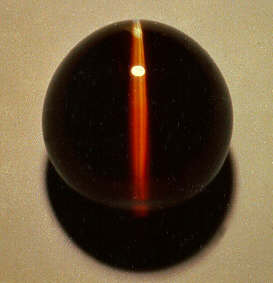Chrysoberyl – Alexandrite and Cat’s-Eye
Ironically, chrysoberyl varieties include two of the world's most exotic and expensive gems, alexandrite and cat's-eye chrysoberyl, while yellow or yellowish-green faceted chrysoberyl is a nondescript variety in the low to moderate price range. Chrysoberyl is a tough and durable gem, which is rare even in its unappreciated faceted variety. Chrysoberyl, unqualified, refers to the yellow to greenish yellow transparent material. In spite of its good qualities, plain old yellow chrysoberyl is overshadowed by the spectacular charm of its siblings.
4 Minute Read
Ironically, chrysoberyl varieties include two of the world's most exotic and expensive gems, alexandrite and cat's-eye chrysoberyl, while yellow or yellowish-green faceted chrysoberyl is a nondescript variety in the low to moderate price range.
Chrysoberyl is a tough and durable gem, which is rare even in its unappreciated faceted variety. Chrysoberyl, unqualified, refers to the yellow to greenish yellow transparent material. In spite of its good qualities, plain old yellow chrysoberyl is overshadowed by the spectacular charm of its siblings.
Alexandrite and Cat's-eye
| Colors: | Yellow, yellowish green, green, brown, violetish red and greenish-blue color change |
| R.I.: | 1.74 - 1.76 |
| Durability: | Tough |
| S.G.: | 3.5 - 3.8 |
| Treatment: | None known |
| Hardness: | 8 1/2 |
| Availability: | Alexandrite and catseye very rare. Yellows available |
| Localities: | Brazil, Sri Lanka and Russia |
| Price: | Low/moderate to very expensive |
| Common shapes: | Ovals, rounds and cushions |
Alexandrite
Alexandrite lives in an aura of mystery unrivaled by any other gemstone. Alexandrite was named after Czar Alexander I of Russia: it was first discovered in Russia on his birthday. Alexandrite was a gem fit for a Czar because it shared both of the royal colors: red and green.
Fine quality alexandrite changes color in different light. You could say it is the color of emerald by daylight, and the color of a ruby by candlelight. In reality it is more accurate to say that in daylight or fluorescent light, it is a medium green to bluish green color and when illuminated by incandescent light-a regular light bulb- it will appear a violetish-red color. The stronger the color change, the more expensive the stone and alexandrite can be very expensive indeed. Lower quality stones will have a less dramatic change, retaining part of the green color in incandescent light or appearing brown in incandescent light.
Alexandrite is fabulously rare. Do not confuse the real thing with the cheap imitation: many tourists have found fabulous buys of "alexandrite", generally in large round stones in Mexico, Beirut, Cairo, and Seoul, and other tourist destinations, for the princely sum of about five dollars. Many people believe they have an alexandrite treasure, but they actually have a synthetic corundum (sapphire) that is doped with chemicals to show a bluish to violetish color change.
Keep in mind a fine natural alexandrite is a truly rare stone; it is unlikely that an exquisite large one with perfect clarity will show up in some foreign market place at a bargain price of five dollars. Gemstones are about the same price around the world. The natural alexandrite does not have the blatant flash of its imitator; the real thing is subtle. The colors are different and no one whoever saw a real alexandrite would be fooled, but most people never get a chance.
Color change is not unique to alexandrite but no other gemstone changes in such an extreme manner. It is really an amazing thing to see. Large stones are very rare and small ones, under five carats, are very expensive if the color change is strong.
Alexandrites can also occur in a cat's-eye form; of course a fine example is terrifically rare and prices increase according to the color change and quality of the eye.
| Cat's-eye Alexandrite, Sri Lanka (Photo by ICA/Bart Curren) |
Inclusions? Like any other stone alexandrites range in clarity from eye clean to heavily flawed; of course, the stone will be valued accordingly if it is exceptionally clean or flawed; but color change is the first consideration.
If you are sincerely in the market for a fine alexandrite, you may have to do some searching to find one. Be prepared to pay a high price for a high quality stone.
Alexandrites, as rare as they are, are mined in Brazil, Sri Lanka, and Russia. Fine stones are also found in Burma and Zimbabwe, but examples of these will be hard to find.
Chrysoberyl Cat's-Eye
The term, cat's-eye, when unqualified, refers to the chrysoberyl cat's-eye; but there are many other species that have "eye" stones. Chatoyant refers to the ability of a gem to display an "eye". Chrysoberyl cat's-eyes really look like the eye of a cat whether it is your household pet or a Siberian tiger.
| Chrysoberyl Cat's-eye, 3.29 carats, Brazil (Photo by ICA/Bart Curren) |
Fine cat's-eyes may be yellow, yellowish green, or golden brown. In the finest qualities, the gems will be semi-transparent and they will exhibit a sharp white eye. As you turn the stone around the eye will move. The best cat's-eyes also exhibit a "milk and honey effect," when the stone is rotated, one side of the stone appears transparent, as other side takes on a creamy appearance. In large cat's-eyes, the milk and honey effect is an important consideration in valuing the stone. Cat's-eyes will always be cut in cabochon.
| Chrysoberyl Cat's-eye. Photo by ICA/Bart Curren) |
Sri Lanka and Brazil produce the most chrysoberyl cat's-eyes. This stone is an excellent choice for men. It has a masculine appeal and it is very durable. A fine quality stone will be in the expensive range. Even a less than perfect one will fall into the expensive range!
You assume all responsibility and risk for the use of the safety resources available on or through this web page. The International Gem Society LLC does not assume any liability for the materials, information and opinions provided on, or available through, this web page. No advice or information provided by this website shall create any warranty. Reliance on such advice, information or the content of this web page is solely at your own risk, including without limitation any safety guidelines, resources or precautions, or any other information related to safety that may be available on or through this web page. The International Gem Society LLC disclaims any liability for injury, death or damages resulting from the use thereof.
The All-In-One Jewelry Making Solution At Your Fingertips
When you join the Ganoksin community, you get the tools you need to take your work to the next level.
Trusted Jewelry Making Information & Techniques
Sign up to receive the latest articles, techniques, and inspirations with our free newsletter.



